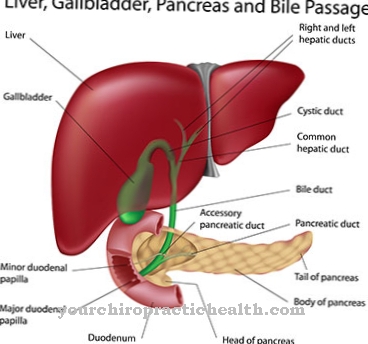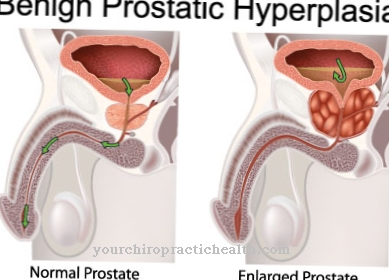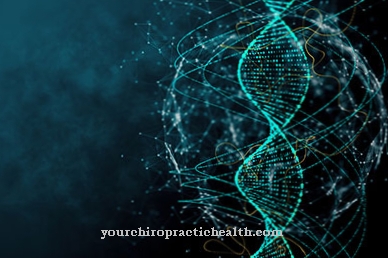The Fowler-Christmas-Chapple Syndrome is a micturition disorder that is often associated with polycystic ovaries and is associated with urinary retention. The complex of symptoms is presumably based on hormonal factors, but so far this connection has not been proven. A causal therapy is currently not available.
What is Fowler-Christmas-Chapple Syndrome?

© designua - stock.adobe.com
The emptying of the bladder is also known as urination. If micturition is associated with discomfort, it may be associated with a so-called micturition disorder. Fowler-Christmas-Chapple syndrome falls into the disease group of micturition disorders. This is one of the most common causes of urinary retention. Nevertheless, the prevalence is given as less than one case in 1,000,000.
The British doctor Clare J. Fowler first described the syndrome towards the end of the 20th century. Her name has been included in the name of the disease in her honor. The symptom complex should not be confused with Fowler's syndrome, which is a disease with changes in blood vessels in the brain.
The Fowler-Christmas-Chapple-Syndrome is sometimes referred to as Fowler’s Syndrome, which suggests that it can easily be confused with that of the congenital brain disease. As a bladder emptying disorder, Fowler-Christmas-Chapple syndrome predominantly affects young women and is often associated with the so-called polycystic ovary syndrome.
causes
In the case of Fowler-Christmas-Chapple syndrome, the cause of the micturition disorder is a disorder of the bladder sphincter. How this disorder occurs and what triggers it is still unknown. The cases have been described in 33 women, almost half of whom also had polycystic ovaries. Since the complex of symptoms has so far often been directly related to polycystic ovaries, scientists are encouraging speculation.
For example, it can be assumed that the stability of the muscle membrane is impaired in patients with the syndrome. This instability could explain the abnormal behavior of the bladder sphincter and, at the same time, the polycystic ovaries, if hormonal abnormalities are assumed to be the primary contributing factor to the two symptoms.
The fact that hormonal abnormalities cause the syndrome is also obvious in view of the average age of onset. The hormonal connection could explain why women are primarily affected by the syndrome well before menopause.
You can find your medication here
➔ Medicines for bladder and urinary tract healthSymptoms, ailments & signs
Fowler-Christmas-Chapple syndrome is characterized by a number of clinical symptoms, all of which are related to micturition behavior. The most characteristic symptom of the syndrome is urinary retention. The affected patients also retain significantly more residual urine than the average after micturition.
The electromyogram shows abnormal muscle activity in the bladder sphincter. Those affected suffer neither from an obvious anatomical abnormality, nor from a neurological disorder. In some cases, urinary tract infections in the form of complications occur due to urinary retention and residual urine. These infections are characterized by a burning sensation when urinating.
With a bladder infection, those affected often think that they have to urinate without an actual urge to urinate. If the patient is also affected by polycystic ovaries, there will also be multiple cysts in the ovaries. Such cysts can cause cycle changes and, if left untreated, even cause infertility in the long term.
diagnosis
In order to diagnose Fowler-Christmas-Chapple syndrome, neurologically induced urination disorders must first be ruled out. In the differential diagnosis, an increased bladder capacity with a volume of over one liter must also be excluded.
The EMG is an indispensable tool for diagnosing the syndrome, as it can be used to detect the unusual activities of the bladder sphincter. The muscle group around the urinary tract usually has the same abnormalities. The behavioral abnormalities of the muscles can be summarized in the broadest sense as unusual contraction behavior.
If there are polycystic ovaries in addition to the micturition disorder, laboratory diagnostics can also be performed. Increased or borderline high testosterone, androstenedione, dehydroepiandrosterone sulfate, TSH, AMH and prolactin speak in the laboratory diagnostic examination as well as an increased LH / FSH quotient.
Complications
As a result of the urinary tract disorder, which is caused by a functional disorder of the bladder sphincter in Fowler-Christmas-Chapple syndrome, acute urinary tract infections often occur. Polycystic ovary syndrome can also be present at the same time. This is the case for half of those affected. Hormonal imbalances may be the cause of Fowler-Christmas-Chapple syndrome and all of the sequelae that result from it.
The cysts in the ovaries can lead to cycle changes as a result. This can lead to infertility without treatment or surgical intervention. Due to the urinary retention, which is typical of Fowler-Christmas-Chapple syndrome, more residual urine remains in the bladder than usual. The resulting bladder infections increase. The patient suffers from a constant need to urinate.
There may be a burning sensation and drawing feeling when urinating. If an acute urinary tract infection is delayed in Fowler-Christmas-Chapple syndrome, it can have dramatic consequences. The delayed urinary tract infection draws attention to itself through blood in the urine or purulent discharge. In the worst case, the urinary tract infection becomes chronic. This can lead to bladder shrinkage and necrotic bladder tissue.
Occasionally, the infection has spread to other female organs. An ascent of the pathogen can affect the kidneys. The possible consequence is kidney abscesses. This in turn can lead to life-threatening blood poisoning. In most cases, such complications in Fowler-Christmas-Chapple syndrome can be ruled out with close medical monitoring.
When should you go to the doctor?
Since the Fowler-Christmas-Chapple syndrome can only be treated symptomatically and there is no self-healing, a doctor must be consulted in any case. Those affected should always consult a doctor with this disease if there is an unusual or disturbed urinary behavior.
A large amount of residual urine can remain in the bladder, so that the person concerned feels an urge to urinate again shortly after using the toilet. Frequent infections of the urinary tract or the bladder should always be examined by a doctor in Fowler-Christmas-Chapple syndrome. The burning sensation when urinating can also be a symptom of this disease. Women should also see a doctor if cysts develop on the ovaries. Changes in the cycle or infertility can also indicate Fowler-Christmas-Chapple syndrome.
The examination and diagnosis of this syndrome takes place in most cases with a urologist. This can usually initiate treatment of the syndrome and limit the patient's symptoms. However, it cannot be universally predicted whether this will lead to a completely positive course of the disease.
Doctors & therapists in your area
Treatment & Therapy
A causal treatment of the Fowler-Christmas-Chapple syndrome does not yet exist, as the causal relationship has not yet been finally clarified.Symptomatic therapy for micturition disorder usually corresponds to either sacral neurostimulation or sacral neuromodulation. The latter therapeutic approach is associated with success rates of up to 70 percent.
This relationship even applies to women who have been suffering from the symptoms for a long time. During therapy, the nerves of the bladder sphincter near the spinal cord are stimulated. After the symptoms have been reduced by half, the stimulator can be implanted in the patient. This step is only taken when neuromodulation has proven to be helpful in individual cases.
The therapy does not work in all cases by far and can be combined with an operation in the case of an implantation. However, other therapeutic approaches for Fowler-Christmas-Chapple syndrome have achieved far less success. This applies, for example, to hormonal manipulation or drug therapy.
If the patient also has polycystic ovaries, treatment must be given in addition to the treatment of the urination disorder. Measures to treat this symptom can range from the prescription of an anti-androgenic birth control pill, a change in diet and the pulsatile administration of GnRH to surgical treatment, for example in the form of a laparoscopic laser triplet of the ovaries.
Outlook & forecast
The prognosis for Fowler-Christmas-Chapple syndrome must be viewed individually. Some patients recover from treatment and have a good prognosis. Others face lifelong impairments despite their best efforts. This is based on the so far not sufficiently clarified cause of the disease.
In medical care, the focus is on alleviating the existing symptoms, as the cause cannot be combated. In the majority of patients, this means that there are no symptoms. The activity of the sacral nerves is stimulated by electrical impulses.
The stimulation leads to the functional activity of the bladder and rectum being stimulated to a sufficient extent. Nevertheless, around thirty percent of those affected do not experience sufficient improvement in their health with this form of therapy. In addition, a large number of patients experience a recurrence of symptoms over the course of their lives.
As an alternative to surgery, there is the possibility of implantation. The procedure is associated with the usual risks and side effects and also does not lead to recovery in many patients. In direct comparison, drug or hormonal treatment has little chance of success. The prognosis is unfavorable for the two therapeutic approaches. Nevertheless, it should be assessed individually, as some patients experience an improvement in their health.
You can find your medication here
➔ Medicines for bladder and urinary tract healthprevention
Although hormonal causes are currently suspected to be causative factors for Fowler-Christmas-Chapple syndrome, this speculation has so far not been confirmed. For this reason, no effective preventive measures are currently available.
Aftercare
The voiding disorder called Fowler-Christmas-Chapple syndrome primarily affects young women. It is based on a disorder in the bladder sphincter. What triggers this is not clear. Because Fowler-Christmas-Chapple syndrome often coexists with polycystic ovarian syndrome, post-operative follow-up care may be required.
Most of the time, however, aftercare is concerned with ensuring that there is no spread of germs into the kidneys after acute urinary tract infections. However, it is problematic that doctors do not know the exact cause of the bladder sphincter disorder. This makes prevention and aftercare equally difficult.
Since this micturition disorder occurs relatively rarely, there is little interest in researching new treatments or aftercare options. Follow-up care is usually carried out by the gynecologist for patients with additional polycystic ovarian syndromes. In this situation, infertility as a result of Fowler-Christmas-Chapple syndrome is possible.
Urologists, on the other hand, are responsible for the direct and indirect consequences of dragged-out urinary tract infections. In follow-up care, it is important to prevent the bladder tissue from becoming necrotic, the bladder from shrinking or the dragged-out urinary tract infection becoming chronic.
Follow-up care is important for Fowler-Christmas-Chapple syndrome because in some cases delayed or ascending infections can lead to kidney problems, sepsis or infections of the female reproductive organs. Close cooperation between urologists and gynecologists would be desirable in the case of Fowler-Christmas-Chapple syndrome.
You can do that yourself
The Fowler-Christmas-Chapple syndrome offers the patient little opportunity to help themselves. There is no spontaneous healing, so symptoms can only be alleviated in cooperation with a doctor.
Mental strengthening is helpful. The patient should understand that the urge to urinate and the failure to urinate are in no way indicative of a mental disorder or a consequence of psychosomatic diseases. In many cases it is difficult to remain calm and reduce the experience of stress.
However, that is exactly what should happen. Calming the symptoms and dealing openly with the complaints helps to reduce irritation and to experience inner relaxation. In addition, specific procedures can be used that contribute to strengthening mental strength or a harmony of the emotional world. Long car or train journeys should be avoided. For internal security, it is helpful if there is always an opportunity to urinate in the immediate vicinity.
Nevertheless, participation in society as well as social life is important. The patient is also damaging his health if he no longer leaves his own home due to the illness. With an optimistic attitude and sufficient flexibility, a reorganization of everyday life can take place so that an exchange with friends and relatives can take place as usual.

.jpg)
.jpg)





















.jpg)



